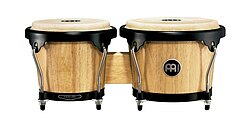
Back طبلة بونجو Arabic Bongó AST Бонгос Bulgarian Bongo BM Bongo Catalan Bongo (hudební nástroj) Czech Bongotromme Danish Bongo (Trommel) German Bongo Esperanto Bongó Spanish
 | |
| Percussion instrument | |
|---|---|
| Other names |
|
| Classification | Percussion |
| Hornbostel–Sachs classification | 211.251.2 (Sets of single-skin conical drums) |
| Developed | Late 19th century in Cuba |
| Related instruments | |
Bongos (Spanish: bongó) are an Afro-Cuban percussion instrument consisting of a pair of small open bottomed hand drums of different sizes.[1] The pair consists of the larger hembra (lit. 'female') and the smaller macho (lit. 'male'), which are joined by a wooden bridge. They are played with both hands and usually held between the legs, although in some cases, as in classical music, they may be played with sticks or mounted on stands.
Bongos are mainly employed in the rhythm section of son cubano and salsa ensembles, often alongside other drums such as the larger congas and the stick-struck timbales. In these groups, the bongo player is known as bongosero and often plays a continuous eight-stroke pattern called martillo (lit. 'hammer') as well as more rhythmically free parts, providing improvisatory flourishes and rhythmic counterpoint.[2]
Bongos originated in eastern Cuba at the end of the 19th century, possibly from a pair of larger drums such as the bokú. These older, larger bongos are known as bongó del monte and played in changüí. The smaller bongos used in son cubano were popular across Cuba by the 1910s and reached the concert halls of the eastern United States in the 1930s. By the 1940s, bongos and congas were sharing the stage as son ensembles grew in size and Latin music began to cross-pollinate with jazz and other genres. During the second half of the 20th century, bongos began to be played in a wide variety of genres, from bachata to Latin rock.[3]
- ^ Strain, James Allen (2017). A Dictionary for the Modern Percussionist and Drummer. Rowman & Littlefield Publishers. p. 23. ISBN 978-0-8108-8693-3. OCLC 974035735.
- ^ Goldberg, Norbert (October 1985). "The Bongos". Percussive Notes. 24 (1): 25–26.
- ^ Fernandez 2006, p. 22–41.